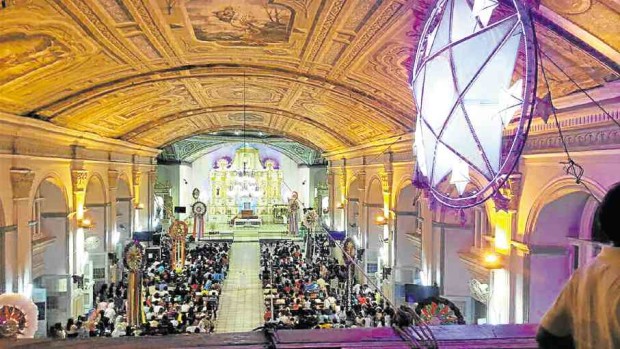
Interior of the Saint Michael the Archangel Church in Jagna, Bohol province, which keeps a 149-year-old tradition alive CONTRIBUTED PHOTO
JAGNA, Bohol—Peregrina Calduza was up before the crack of dawn on Christmas Eve.
She wanted to join her family in Mass at Saint Michael the Archangel Church but she was told to stay at home due to her frail condition.
Calduza, 78, a resident of Barangay Bunga Mar, missed the annual Christmas Eve tradition of this town, “Padagan sa Kometa (Gliding of the Comet).”
Hundreds of devotees flocked to the church at 9:30 a.m. on Dec. 24, not just to hear Mass but to witness the dramatization of a biblical story about a bright star that guided the Three Kings and shepherds to the manger where lay the infant Jesus.
Msgr. Ignacio Reyes, parish priest of Jagna, said based on church records, the dramatization dated back to 1867 when parishioners stopped being content with decorating the church with just small stars.
Church records showed that the tradition was never interrupted even during the Japanese occupation in World War II.
During the war, the community moved out of the poblacion to the hills in Sitio Sun-ok, Barangay Tejero. There, the community built a makeshift church.
Then parish priest Rev. Fr. Filomeno Lucero and his assistant, Rev Fr. Aguedo Cimafranca, continued the annual Padagan.
Before the start of Dawn Masses, parishioners hang their stars near the mezzanine above the church door.
Volunteers build a comet model that unfolds with the help of a pulley to its full size on Christmas Eve. The pulley mechanism brings the comet gliding above a model manger near the altar.
This year, the comet is at least 3 meters in diameter. Twelve smaller stars hang from the church ceiling, each about one and a half meters in diameter with tails about 3 meters long each.
At the Mass on Saturday, Reyes and the choir sang “Gloria in Excelsis Deo” as church lights dimmed and the bright comet slowly glided across the church, passing the 12 smaller stars.
It took at least 10 men to control the ropes that held the comet to the pulley, making the comet move up and down as it continued its glide toward the manger.
Once the comet is directly above the manger, it is made to move down thrice as a sign of respect to the infant Jesus. It would stay there until Jan. 3, the Feast of Three Kings.